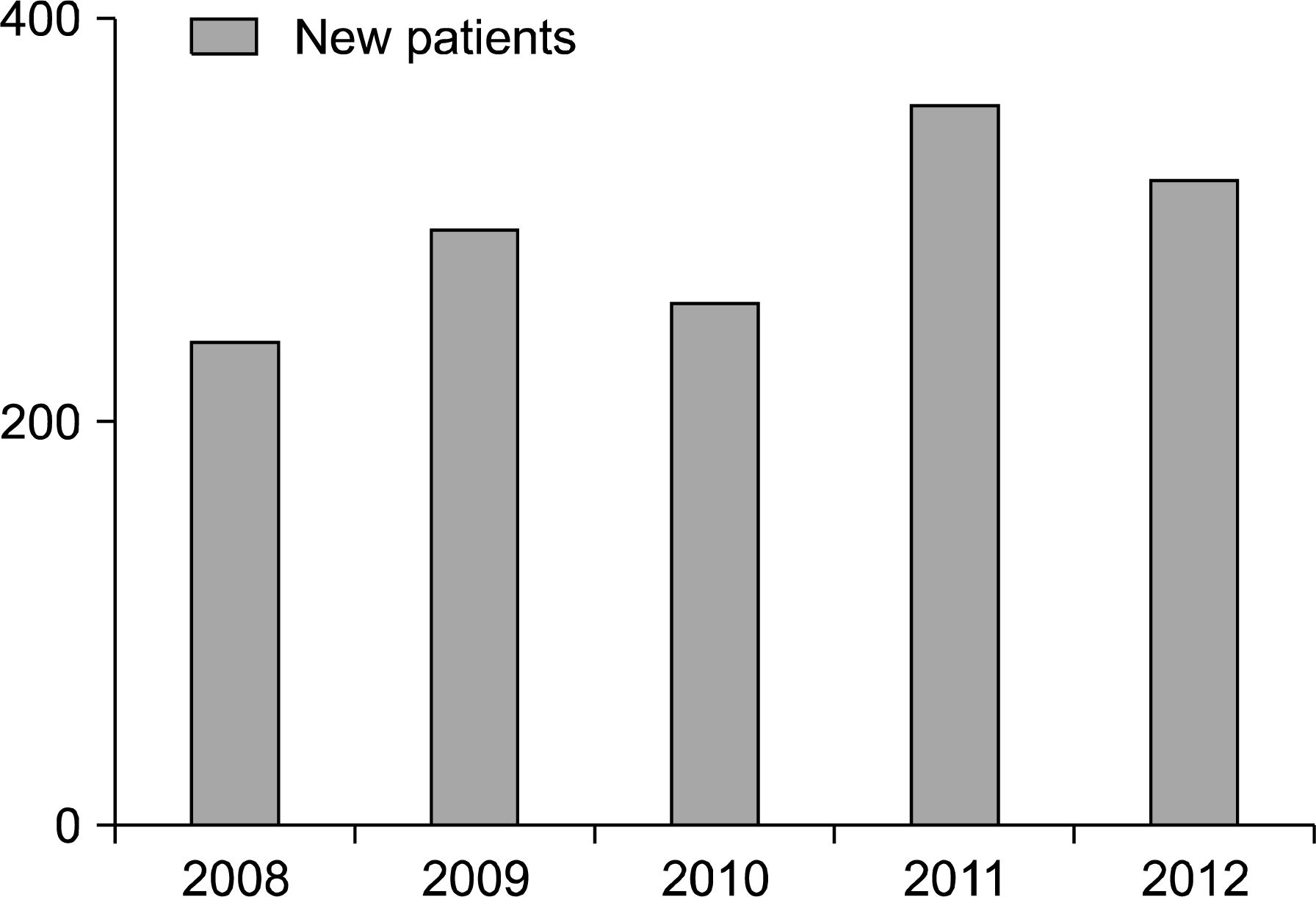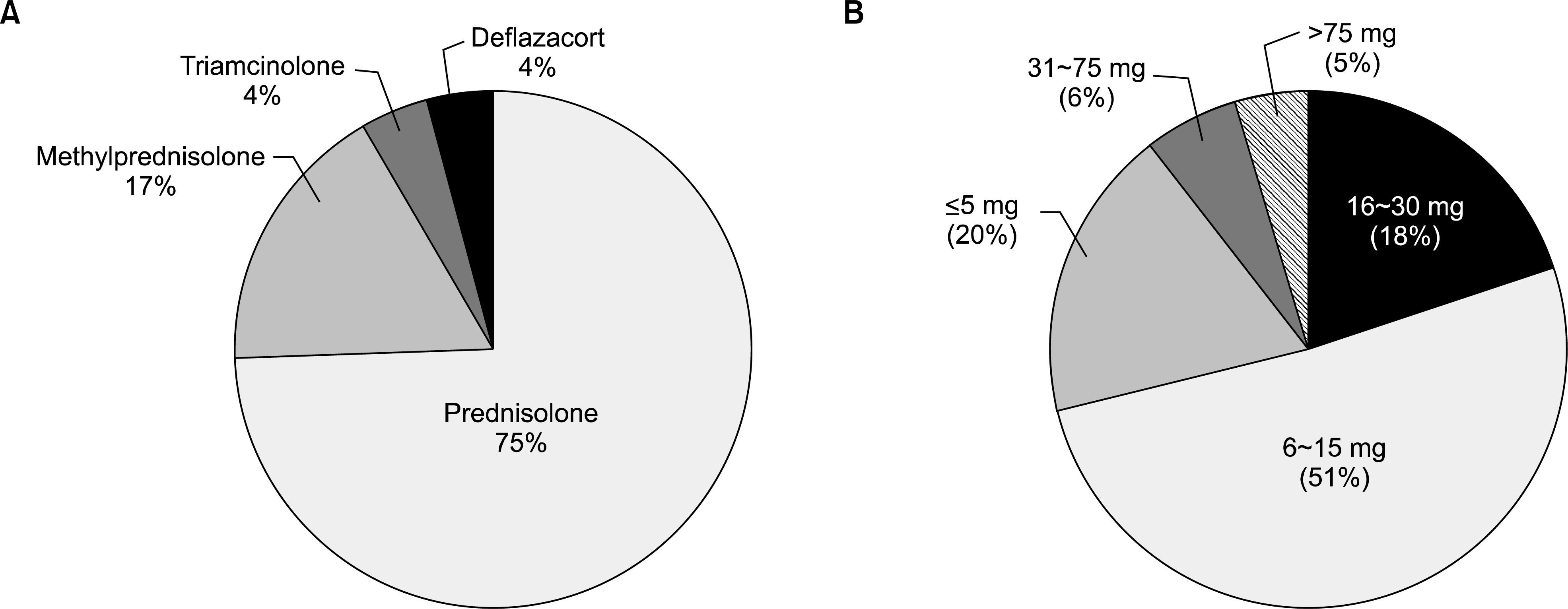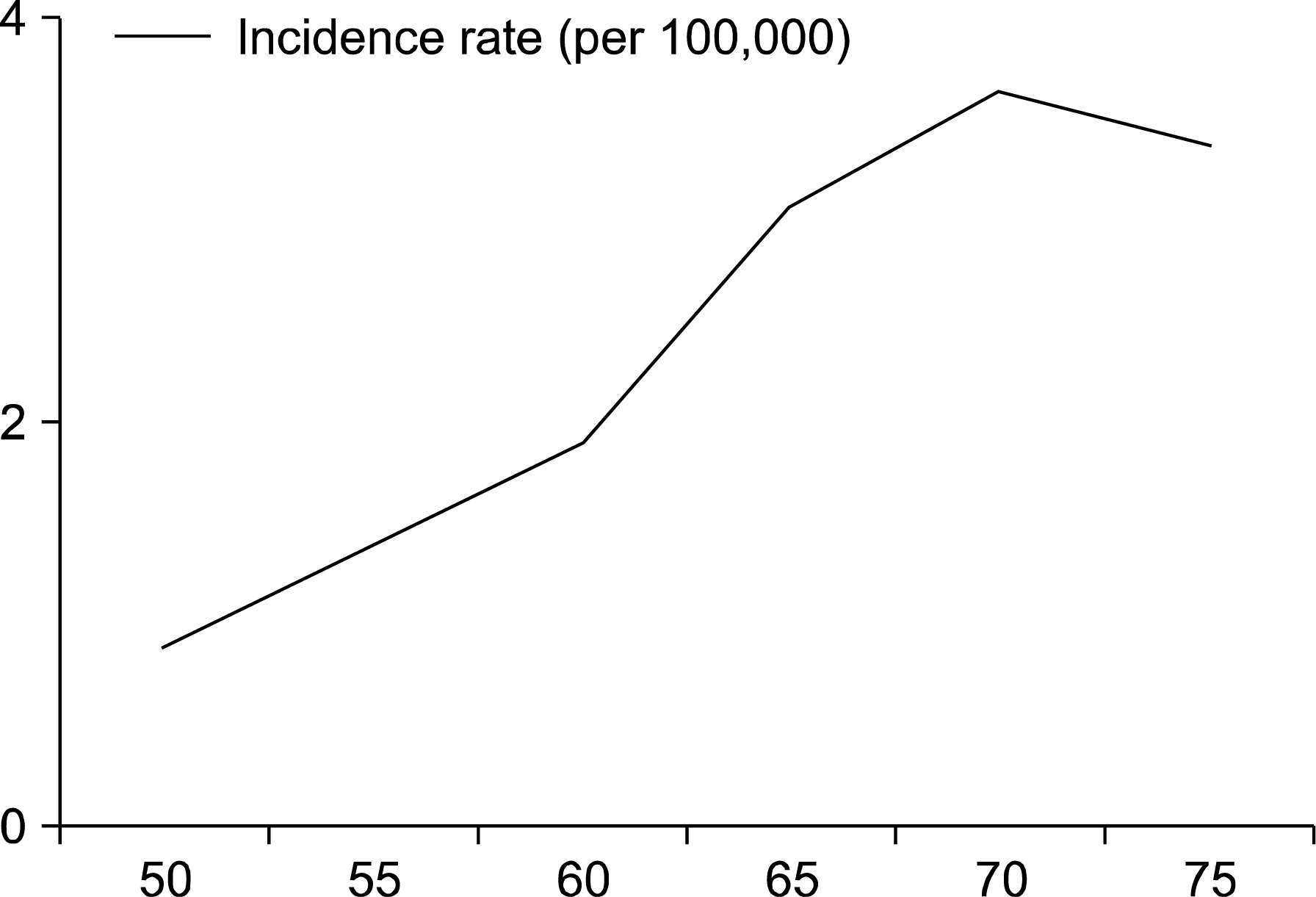Abstract
Objective
Polymyalgia rheumatica is a chronic inflammatory disease that affects people older than 50 years of age. The diagnosis is made based on clinical features, and the current standard of treatment is low-dose glucocorticoids. PMR is more commonly reported in Caucasians and females. However, epidemiological studies of PMR in Asian countries are scarce. We aimed to estimate the epidemiology of PMR in Korea.
Methods
This study was conducted by analyzing the Health Insurance Review and Assessment databases. We verified all claims between 2007 and 2012. Cases were included when PMR ICD-10 code (M 35.3) was recorded more than twice, and glucocorticoids were prescribed for ≥30 days.
Results
We identified 1,463 newly diagnosed cases of PMR during the 5 years. Among them, 992 (67.8%) were female, and the mean age at diagnosis was 66.9 years old. The annual incidence rate was 2.06 per 100,000 individuals aged over 50 years. The prevalence rate was 8.21 per 100,000 individuals in 2012. Incidence and prevalence appeared to increase with age. Prednisolone was the most commonly prescribed glucocorticoid. In half of the patients, the daily starting dose was 6∼15 mg as prednisolone equivalents.
Conclusion
This is the first study to investigate the epidemiology of PMR in Korea. The incidence and prevalence appeared to be considerably lower than those in Western populations. Both genetic and environmental factors might influence disease occurrence. In addition, the actual incidence may have been underestimated due to lack of awareness of PMR in clinical practice.
Go to : 
REFERENCES
2. Gonzalez-Gay MA, Vazquez-Rodriguez TR, Lopez-Diaz MJ, Miranda-Filloy JA, Gonzalez-Juanatey C, Martin J, et al. Epidemiology of giant cell arteritis and polymyalgia rheumatica. Arthritis Rheum. 2009; 61:1454–61.

3. Doran MF, Crowson CS, O'Fallon WM, Hunder GG, Gabriel SE. Trends in the incidence of polymyalgia rheumatica over a 30 year period in Olmsted County, Minnesota, USA. J Rheumatol. 2002; 29:1694–7.
4. Okumura T, Tanno S, Ohhira M, Nozu T. The rate of polymyalgia rheumatica (PMR) and remitting seronegative symmetrical synovitis with pitting edema (RS3PE) syndrome in a clinic where primary care physicians are working in Japan. Rheumatol Int. 2012; 32:1695–9.

5. Kim HA, Lee J, Ha YJ, Kim SH, Lee CH, Choi HJ, et al. Induction of remission is difficult due to frequent relapse during tapering steroids in Korean patients with polymyalgia rheumatica. J Korean Med Sci. 2012; 27:22–6.

6. Lee JH, Choi ST, Kim JS, Yoon BY, Kwok SK, Kim HS, et al. Clinical characteristics and prognostic factors for relapse in patients with polymyalgia rheumatica (PMR). Rheumatol Int. 2013; 33:1475–80.

7. Dasgupta B, Cimmino MA, Maradit-Kremers H, Schmidt WA, Schirmer M, Salvarani C, et al. 2012 provisional classification criteria for polymyalgia rheumatica: a European League Against Rheumatism/American College of Rheumatology collaborative initiative. Ann Rheum Dis. 2012; 71:484–92.

8. Hutchings A, Hollywood J, Lamping DL, Pease CT, Chakravarty K, Silverman B, et al. Clinical outcomes, quality of life, and diagnostic uncertainty in the first year of polymyalgia rheumatica. Arthritis Rheum. 2007; 57:803–9.

9. Salvarani C, Cantini F, Boiardi L, Hunder GG. Polymyalgia rheumatica and giant-cell arteritis. N Engl J Med. 2002; 347:261–71.

10. Jones JG, Hazleman BL. Prognosis and management of polymyalgia rheumatica. Ann Rheum Dis. 1981; 40:1–5.

11. Healey LA. Long-term follow-up of polymyalgia rheumatica: evidence for synovitis. Semin Arthritis Rheum. 1984; 13:322–8.

12. González-Gay MA, Amoli MM, Garcia-Porrua C, Ollier WE. Genetic markers of disease susceptibility and severity in giant cell arteritis and polymyalgia rheumatica. Semin Arthritis Rheum. 2003; 33:38–48.

13. Gonzalez-Gay MA, Hajeer AH, Dababneh A, Garcia-Porrua C, Mattey DL, Amoli MM, et al. IL-6 promoter polymorphism at position-174 modulates the phenotypic expression of polymyalgia rheumatica in biopsy-proven giant cell arteritis. Clin Exp Rheumatol. 2002; 20:179–84.
14. Gonzalez-Gay MA, Garcia-Porrua C, Ollier WE. Polymyalgia rheumatica and biopsy-proven giant cell arteritis exhibit different HLA-DRB1* associations. J Rheumatol. 2003; 30:2729.
15. Cid MC, Ercilla G, Vilaseca J, Sanmarti R, Villalta J, Ingelmo M, et al. Polymyalgia rheumatica: a syndrome associated with HLA-DR4 antigen. Arthritis Rheum. 1988; 31:678–82.

17. Frearson R, Cassidy T, Newton J. Polymyalgia rheumatica and temporal arteritis: evidence and guidelines for diagnosis and management in older people. Age Ageing. 2003; 32:370–4.

18. Franzén P, Sutinen S, von Knorring J. Giant cell arteritis and polymyalgia rheumatica in a region of Finland: an epidemiologic, clinical and pathologic study, 1984-1988. J Rheumatol. 1992; 19:273–6.
19. Salvarani C, Cantini F, Hunder GG. Polymyalgia rheumatica and giant-cell arteritis. Lancet. 2008; 372:234–45.

20. Salvarani C, Crowson CS, O'Fallon WM, Hunder GG, Gabriel SE. Reappraisal of the epidemiology of giant cell arteritis in Olmsted County, Minnesota, over a fif-ty-year period. Arthritis Rheum. 2004; 51:264–8.

21. Chang HK, Hur SH, Chung HR. A Case of Giant Cell Arteritis developed in Polymyalgia Rheumatica. J Korean Rheum Assoc. 2000; 7:72–6.
22. Seo JW, Hur J, Kim HO, Jeon DH, Baek JH, Kim JH, et al. A case of atypical giant cell arteritis presenting as raynaud's phenomenon and diagnosed by random temporal artery biopsy. J Korean Rheum Assoc. 2010; 17:278–82.

23. Kang MI, Park HJ, Jeon HM, Kang Y, Lee SW, Lee SK, et al. A case of atypical giant cell arteritis presenting as a fever of unknown origin. J Rheum Dis. 2012; 19:299–301.

24. Herná ndez-Rodríguez J, Cid MC, López-Soto A, Espigol-Frigolé G, Bosch X. Treatment of polymyalgia rheumatica: a systematic review. Arch Intern Med. 2009; 169:1839–50.
25. Dasgupta B, Borg FA, Hassan N, Barraclough K, Bourke B, Fulcher J, et al. BSR and BHPR Standards, Guidelines and Audit Working Group. BSR and BHPR guidelines for the management of polymyalgia rheumatica. Rheumatology (Oxford). 2010; 49:186–90.

26. Gabriel SE, Sunku J, Salvarani C, O'Fallon WM, Hunder GG. Adverse outcomes of antiinflammatory therapy among patients with polymyalgia rheumatica. Arthritis Rheum. 1997; 40:1873–8.

27. Barraclough K, Liddell WG, du Toit J, Foy C, Dasgupta B, Thomas M, et al. Polymyalgia rheumatica in primary care: a cohort study of the diagnostic criteria and outcome. Fam Pract. 2008; 25:328–33.

28. Salvarani C, Cantini F, Niccoli L, Macchioni P, Consonni D, Bajocchi G, et al. Acutephase reactants and the risk of relapse/recurrence in polymyalgia rheumatica: a prospective followup study. Arthritis Rheum. 2005; 53:33–8.

29. Kremers HM, Reinalda MS, Crowson CS, Zinsmeister AR, Hunder GG, Gabriel SE. Relapse in a population based cohort of patients with polymyalgia rheumatica. J Rheumatol. 2005; 32:65–73.
30. Leeb BF, Bird HA, Nesher G, Andel I, Hueber W, Logar D, et al. EULAR response criteria for polymyalgia rheumatica: results of an initiative of the European Collaborating Polymyalgia Rheumatica Group (subcommittee of ESCISIT). Ann Rheum Dis. 2003; 62:1189–94.

31. Leeb BF, Rintelen B, Sautner J, Fassl C, Bird HA. The polymyalgia rheumatica activity score in daily use: proposal for a definition of remission. Arthritis Rheum. 2007; 57:810–5.

32. Binard A, de Bandt M, Berthelot JM, Saraux A. Inflammatory Joint Disease Working Group of the French Society for Rheumatology. Performance of the polymyalgia rheumatica activity score for diagnosing disease flares. Arthritis Rheum. 2008; 59:263–9.

33. Caporali R, Cimmino MA, Ferraccioli G, Gerli R, Klersy C, Salvarani C, et al. Systemic Vasculitis Study Group of the Italian Society for Rheumatology. Prednisone plus methotrexate for polymyalgia rheumatica: a randomized, double-blind, placebo-controlled trial. Ann Intern Med. 2004; 141:493–500.
Go to : 
 | Figure 1.A total of 1,463 polymyalgia rheumatica (PMR) cases were newly diagnosed between 2008 and 2012. More specifically, 238, 294, 258, 354 and 319 were newly diagnosed each year. |
 | Figure 3.(A) Glucocorticoids prescribed for treating PMR in Korea. (B) Daily glucocorticoids starting doses, as prednisolone equivalents to treat PMR in Korea. |
Table 1.
Detailed prevalence rates of PMR according to age and sex




 PDF
PDF ePub
ePub Citation
Citation Print
Print



 XML Download
XML Download